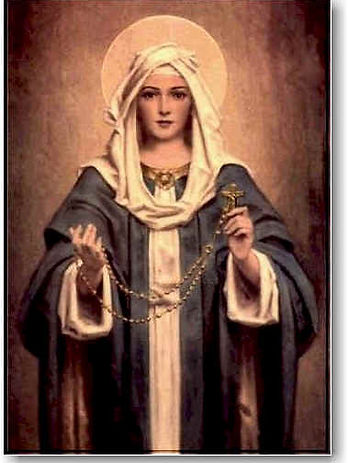The apparition of Our Lady of the Rosary is by tradition attributed to Saint Dominic in 1208 in the church of Prouille, in France.
According to the attribution, the Virgin Mary appeared to Saint Dominic and introduced him to the rosary.
Some sources suggest that Alan de Rupe (rather than Saint Dominic) was the major influence on the rosary in the 15th century, while other sources seek a middle ground to these two views.[30][31] For centuries, Dominicans became instrumental in spreading the rosary and emphasizing the Catholic belief in the power of the rosary.
In 1571 Pope Pius V instituted "Our Lady of Victory" as an annual feast to commemorate the victory of Lepanto, the victory being attributed to Our Lady. In 1969, Pope Paul VI changed the name of the feast to Our Lady of the Rosary.
http://www.americancatholic.org/Features/Saints/saint.aspx?id=1161#tagAudio
"Our Lady of Victory" redirects here.
Our Lady of the Rosary also known as Our Lady of the Most Holy Rosary is a title of the Blessed Virgin Mary in relation to the Rosary.
In 1571 Pope Pius V instituted "Our Lady of Victory" as an annual feast to commemorate the victory in the Battle of Lepanto.[1][2][3] The victory was attributed to the Blessed Virgin Mary, as a rosary procession had been offered on that day in St. Peter's Square in Rome for the success of the mission of the Holy League to hold back Muslim forces from overrunning Western Europe. In 1573, Pope Gregory XIII changed the title of this feast-day to "Feast of the Holy Rosary". This feast was extended by Pope Clement XI to the whole of the Latin Rite, inserting it into the Roman Catholic calendar of saints in 1716, and assigning it to the first Sunday in October. Pope Pius X changed the date to 7 October in 1913, as part of his effort to restore celebration of the liturgy of the Sundays.
Prior to the Battle of Lepanto, in thanks for the victory of the Battle of Muret, Simon de Montfort, 5th Earl of Leicester built the first shrine dedicated to Our Lady of Victory.
Our Lady of the Rosary is the patron saint of several places around the world and María del Rosario is a common female Spanish name (colloquially abbreviated to Rosario or Charo). Rosario can also be used as a male first name, particularly in Italian.
Pope St. Pius V established this feast in 1573. The purpose was to thank God for the victory of Christians over the Turks at Lepanto—a victory attributed to the praying of the rosary. Clement XI extended the feast to the universal Church in 1716.
The development of the rosary has a long history. First, a practice developed of praying 150 Our Fathers in imitation of the 150 Psalms. Then there was a parallel practice of praying 150 Hail Marys. Soon a mystery of Jesus' life was attached to each Hail Mary. Though Mary's giving the rosary to St. Dominic is recognized as a legend, the development of this prayer form owes much to the followers of St. Dominic. One of them, Alan de la Roche, was known as "the apostle of the rosary." He founded the first Confraternity of the Rosary in the 15th century. In the 16th century the rosary was developed to its present form—with the 15 mysteries (joyful, sorrowful and glorious). In 2002, Pope John Paul II added the Mysteries of Light to this devotion.
Comment:
The purpose of the rosary is to help us meditate on the great mysteries of our salvation. Pius XII called it a compendium of the gospel. The main focus is on Jesus—his birth, life, death and resurrection. The Our Fathers remind us that Jesus' Father is the initiator of salvation. The Hail Marys remind us to join with Mary in contemplating these mysteries. They also make us aware that Mary was and is intimately joined with her Son in all the mysteries of his earthly and heavenly existence. The Glorys remind us that the purpose of all life is the glory of the Trinity.
The rosary appeals to many. It is simple. The constant repetition of words helps create an atmosphere in which to contemplate the mysteries of God. We sense that Jesus and Mary are with us in the joys and sorrows of life. We grow in hope that God will bring us to share in the glory of Jesus and Mary forever.
Quote:
“The rosary, though clearly Marian in character, is at heart a Christ-centered prayer. It has all the depth of the gospel messge in its entirety. It is an echo of the prayer of Mary, her perennial Magnificat for the work of the redemptive Incarnation which began in her virginal womb.... It can be said that the rosary is, in some sense, a prayer-commentary on the final chapter of the Vatican II Constitution Lumen Gentium, a chapter that discusses the wondrous presence of the Mother of God in the mystery of Christ and the Church" (Pope John Paul II, apostolic letter The Rosary of the Virgin Mary).
Our Lady of the Rosary







